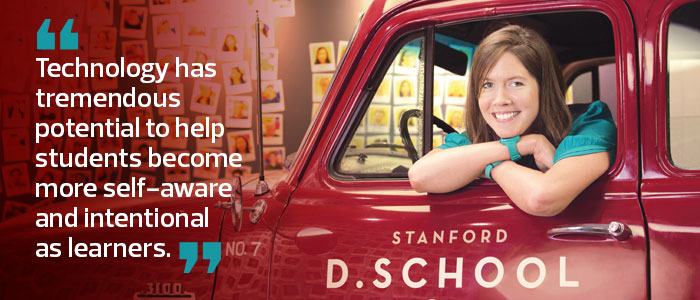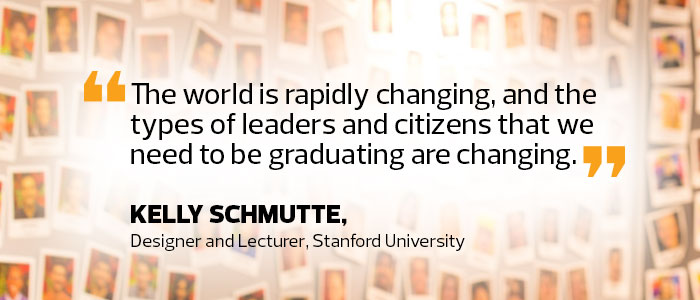Q&A: Stanford University's Kelly Schmutte on Changing the Undergrad Experience
Kelly Schmutte is a designer and lecturer at Stanford University’s Hasso Plattner Institute of Design and a lecturer in mechanical engineering design. She also managed the @Stanford Project, a yearlong initiative to reimagine the undergraduate experience. The project culminated in Stanford2025, an online and in-person exhibit on higher education circa 2025, imagined from the perspective of the year 2100.
Schmutte recently spoke with EdTech Managing Editor Amy Burroughs about the project’s bold new concepts for education: lifelong learning; paced education, replacing the freshman-to-senior model with Calibrate, Activate and Elevate learning phases; skills-based curricula; and purposeful learning, in which students pursue missions instead of majors.
EDTECH: What were the objectives of the @Stanford Project?
SCHMUTTE: The project was sparked by a conversation between Professor David Kelley and a friend about the future of online learning, which made them wonder, what’s the future of the on-campus experience? What will the value of an experiential, residential education be? Can our current system produce the creative thinkers we need to solve tomorrow’s problems? At the end of the year, we wanted to have a collection of big ideas about the future of living and learning at Stanford in a sharable format (stanford2025.edu) that would serve as provocations for experimentation.
EDTECH: Why is it important for institutions to occasionally step back and reimagine familiar educational models?
SCHMUTTE: The world is rapidly changing, and the types of leaders and citizens that we need to be graduating are changing. Our problems are more challenging and ambiguous. Especially at high-achieving schools like Stanford, kids come from super-structured environments, yet we send them out into a complex world with messy problems and hope they are equipped to solve those problems.

EDTECH: What interesting insights emerged from the project?
SCHMUTTE: At the Stanford2025 exhibit, each of the four futures had an activity that people could participate in. For purpose learning, we had people declare their mission and write it on a big piece of paper, and we took a Polaroid picture of them and put it on the wall. People loved it. It tapped into the desire to connect what you’re doing to something more meaningful. It’s important to give students time to think about the “why” behind what they’re doing, so they can navigate their educational journey in an intentional, meaningful way. We’re not as intentional as we could be in creating the time and space for those thoughtful reflections.
A trend that we saw in our research is that people are cycling through jobs faster. According to the U.S. Bureau of Labor Statistics, the average worker stays in each of his or her jobs for about four and a half years, but the expected tenure of younger employees is about half that. It ties back to the idea that young people are looking for work that’s meaningful, and they’re willing to move around to find that. Why can’t higher education morph to mirror that dynamic career trajectory and provide learning opportunities throughout life?
EDTECH: Assuming that technology’s role in higher education will continue to grow, what did you learn about the future role of technology on campus?
SCHMUTTE: Technology has tremendous potential to help students become more self-aware and intentional as learners. One of our concepts was something we called the Grit Bit — like a Fitbit, but for learning. Imagine a tool that tracks metrics related to students’ progress: stress and mood levels, physical activity, social activity and physical location. It then helps you make correlations among those factors and how you’re performing toward learning goals. Technology could help you collect a lot of valuable data that would help you be a smarter learner
In our imagined future, you see more student agency, individualization and self-pacing as people progress at different rates. That presents logistical challenges for how we structure classes and allocate living space. Technology on the back end could help us sort out those complex logistics to better utilize learning, working and living spaces.
Similarly, we might start to develop an archive of students’ learning paths, so that incoming students could study the paths that earlier students pursued. You could find someone who inspires you or has a similar mission, see how they looped through Stanford and use that to guide your own journey. Technology could help us track those paths and identify trends to learn what paths make the most sense.

EDTECH: How can leaders use technology to take a new look at old educational models?
SCHMUTTE: There’s always value in leveraging technology in new and interesting ways and in pairing quantitative data with qualitative research. Whatever data you collect, you have to find the human story behind it — the individual stories of students, faculty and administrators. Real human needs are what inspire change.
For the Stanford2025 exhibit, we recruited current undergrads and gave them profiles as if they were students in the year 2100 who were docents of this retrospective exhibit. They gave a personal account of what it was like to declare a mission, or to live with a cohort of students during the Elevate phase, and it made all those concepts personal. That’s important when deciding what to change and when inspiring that change to happen: remembering the human need behind it.








